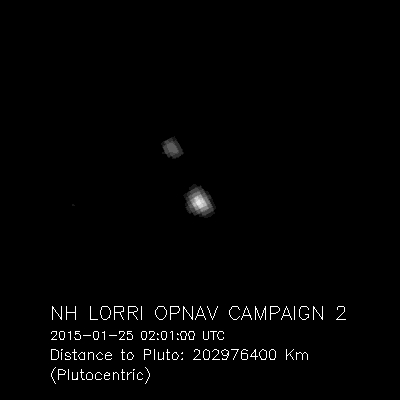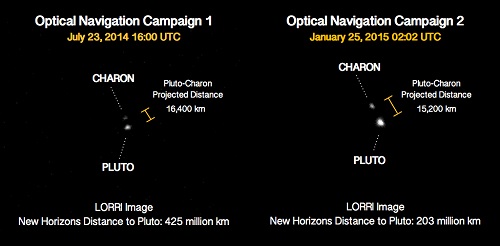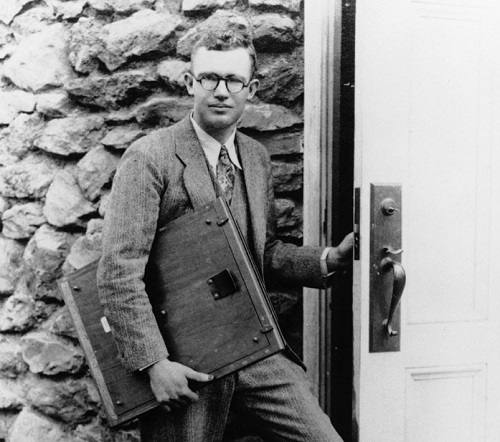Watching Ceres gradually take on focus and definition is going to be one of the great pleasures of February. The latest imagery comes from February 4, with the spacecraft having closed to about 145,000 kilometers. Here we’re looking at a resolution of 14 kilometers per pixel, the best to date, but only a foretaste of what’s to come. For perspective, keep in mind that while Ceres is the largest object in the main asteroid belt, its diameter is a scant 950 kilometers. Is there an ocean under this surface?

Image credit: NASA/JPL-Caltech/UCLA/MPS/DLR/IDA/PSI.
Meanwhile, a good deal further out in the system, a small vial of Clyde Tombaugh’s ashes continues its remarkable trek, with new imagery from New Horizons, the spacecraft carrying it, being released on the same day the Ceres images were taken, February 4, which happens to be Tombaugh’s birthday. Born in 1906, Tombaugh’s long life ended in 1997, and he has stayed very much in the thoughts of New Horizons principal investigator Alan Stern, who commented:
“This is our birthday tribute to Professor Tombaugh and the Tombaugh family, in honor of his discovery and life achievements — which truly became a harbinger of 21st century planetary astronomy. These images of Pluto, clearly brighter and closer than those New Horizons took last July from twice as far away, represent our first steps at turning the pinpoint of light Clyde saw in the telescopes at Lowell Observatory 85 years ago, into a planet before the eyes of the world this summer.”

As with Ceres, we’ll be watching a distant speck turn into an actual place with features we’ll need to name as this year moves forward. The image at left, taken at a distance of over 200 million kilometers, come from New Horizons’ telescopic Long-Range Reconnaissance Imager (LORRI), an animation assembled from separate images taken on January 25 and January 27, which makes them the first acquired during the approach phase of the mission. The spacecraft’s flyby of Pluto/Charon takes place on July 14.
Image: A long distance look from LORRI: Pluto and Charon, the largest of Pluto’s five known moons, seen Jan. 25 and 27, 2015, through the telescopic Long-Range Reconnaissance Imager (LORRI) on NASA’s New Horizons spacecraft. New Horizons was about 203 million kilometers from Pluto when the frames to make the first image were taken; about 2.5 million kilometers closer for the second set. These images are the first acquired during the spacecraft’s 2015 approach to the Pluto system, which culminates with a close flyby of Pluto and its moons on July 14. Credit: NASA/Johns Hopkins University Applied Physics Laboratory/Southwest Research Institute.
So now New Horizons is giving us Pluto at the 2-pixel level, with Charon subtending 1 pixel as seen by LORRI, which JHU/APL describes as ” essentially a digital camera with a large telephoto telescope.” The exposure time here is one-tenth of a second, too short to make any of Pluto’s other moons, much smaller than Charon, visible. We’ll have the satisfaction of watching this system grow in our field of view over the coming months. Along the way, New Horizons will take many images of Pluto against background stars to refine distance estimates and plan course corrections needed for the flyby.

Image: Six Months of Separation: A comparison of images of Pluto and its large moon Charon, taken in July 2014 and January 2015. Between takes, New Horizons had more than halved its distance to Pluto, from about 425 million kilometers to 203 million kilometers. Pluto and Charon are four times brighter than and twice as large as in July, and Charon clearly appears more separated from Pluto. These two images are displayed using the same intensity scales. In LORRI’s current view, Pluto and Charon subtend just 2 pixels and 1 pixel, respectively, compared to 1 pixel and 0.5 pixels last July. The images were magnified four times to make Pluto and Charon more visible. Both images were rotated to show the celestial north pole at the top. Credit: NASA/Johns Hopkins University Applied Physics Laboratory/Southwest Research Institute.
As to Clyde Tombaugh, whenever I think of him, I think of Michael Byers’ splendid portrait in his novel Percival’s Planet (Henry Holt, 2010), although to be sure, Byers focuses not just on Tombaugh but on the entire enterprise of planet-finding and the nature of obsession (the latter being Percival Lowell’s fixation on ‘Planet X’ as well as the private demons of his subordinates). My earlier review of Percival’s Planet is here. Tombaugh was a Kansas farmboy who could grind lenses like no one else, a self-educated master craftsman whose eye for detail would change our view of the Solar System. What a pleasure to hear the words of his daughter in this New Horizons news release:
“My dad would be thrilled with New Horizons,” said Annette Tombaugh, Clyde Tombaugh’s daughter, of Las Cruces, New Mexico. “To actually see the planet that he had discovered and find out more about it, to get to see the moons of Pluto … he would have been astounded. I’m sure it would have meant so much to him if he were still alive today.”

My favorite photograph of Tombaugh has always been the one above (from the collection at New Mexico State University). Look at the sheer determination in that face! This is a man who knows what he is about — I wish I had known him.



2015 is an exciting year, Ceres and Pluto. Pray for clipper at Europa.
I met Clyde Tombaugh in July 1995 at his modest desert home, introduced by my middle aged friend Sandy who had been one of his students. Both he and his wife were charming, and his mind was still sharp. I am glad that a bit of Clyde is along for the ride with New Horizons.
Sandy and I then drove on to White Sands missile range to observe a DC-X flight with Pete Conrad at the controls! Unfortunately the DC-X was one of many false starts on the road to reusable rockets, joining the 1980s National Aerospace Plane boondoggle (wasted: $1 billion, no flight hardware) , later joined by the 1990s Venture Star (also an expensive boondoggle which never flew), and failed startups Rotary Rocket, and the Kistler K-1. At least McDD built a rocket, and flew it repeatedly, which is more than can be said for all of the rest. Now 20 years later, seeing Elon Musk on the verge of flyback booster success is almost too good to be true.
PS: The white spot on Ceres is very suggestive of a recent crater exposing ice isn’t it? We will know much more shortly, yay!
I was waiting for Dawn and New Horizons missions for years, it is hard to believe the time is finally coming. I am quite interested on both dwarf planets. While Pluto still looking just as a light ball, we already can see nice details of Ceres surface, can’t wait until we can finally know what exactly is the bright spots (former THE bright spot, now multiples) and take a closer look on them. I wondering if we will find any remarkable feature on it’s surface besides the bright spots, i was always wondering if Ceres has any atmosphere at all that can shape some interesting features on it’s surface, even if i know the odds are low and if there is one, it will be thiner than Pluto, for know unfortunately seems it has not, but i still have hope.
Anyway, i am excited about it, as i am aware of the picture of february 25 will have the best resolution until april 10 if i get the table information correct, can’t wait for it.
It’s hard to believe we are living on such a rich time of space exploration, we have tons of high resolution Mars suface pictures, rovers launching often. It is a shame NASA has such budget constraints to do more, government is not THAT interested on space exploration, they always give NASA the minium necessary, usually reducing NASA power if you consider the percentage of the federal budget they get, that is reducing every year. Anyway space agencies around the world are fas growing, meaning we might expect great development next decades. Why not a rover on Ceres, an orbiter on Uranus, increased exploration on Titan (such a rich environment to study) and bold missions to penetrate through Europa’s ice shell, reaching the liquid water ocean, NASA can do it all, just need the money, hope this budget issue gets better as time goes.
Can this thing go any faster!
From the new images it looks a lot like Rhea a small moon around Saturn but with more relieved equatorial impact features.
http://solarsystem.nasa.gov/images/rhea_PIA06578-260.jpg
@lepton
‘2015 is an exciting year, Ceres and Pluto. Pray for clipper at Europa.’
Pray for clipper but vote for a lander sample return mission to Ceres!
With around a tenth of the light for solar power but only one thirty sixth the gravity of Earth a rover or hopper would do well here. This place looks mighty mining friendly with all that mineral and metal rich dust on the surface wow!
“I wish I had known him”
Me too Paul. A giant of a genius.
Ceres looks a bit like a golf ball ! (Seriously!)
In my office hangs a framed photo and autograph of Tombaugh. I often stare at it when I’m tired, frustrated or discouraged. After a few minutes of reflection I always get a sense of encouragement and feel ready to continue my task. If my house was burning and I could only save one thing from my walls, this photo would be it.
At the current low resolution, it looks as if there are two fresh craters. The rest of the surface looks very old. Unlike Dione or Enceladus there does not appear to been any significant resurfacing (at least on the side visible). Interesting that nearly every visible crater has a large central peak.
When looking at the current magnified image of Ceres I can’t help myself but comparing it to Vesta. The size of impact craters remind more features of Vesta than anything else. Compare with close up images of Enceladus & one can clearly see these are two different celestial bodies making Ceres / Vesta more alike than Ceres compared to other plausible subsurface ocean candidates.
Enceladus overall picture back lit by Saturn.
https://twitter.com/Wikisteff/status/563886745511792641
Encaladu close up with terminal.
https://twitter.com/WorldNScience/status/563755343923384320
Encaledus crust close up.
https://twitter.com/_Spasmolytic_/status/562719573343211521
Not enhanced picture of Enceladus surface @ 30 000 km. Does not resemble Ceres in any way.
https://twitter.com/SPACEPlCTURES/status/539587343142109184
Michael-as mentioned in the other discussion, Chinese are thinking about a sample return to Ceres.
Personally I think missions to Enceladus, Europa and Triton are the most exciting ideas at the moment.